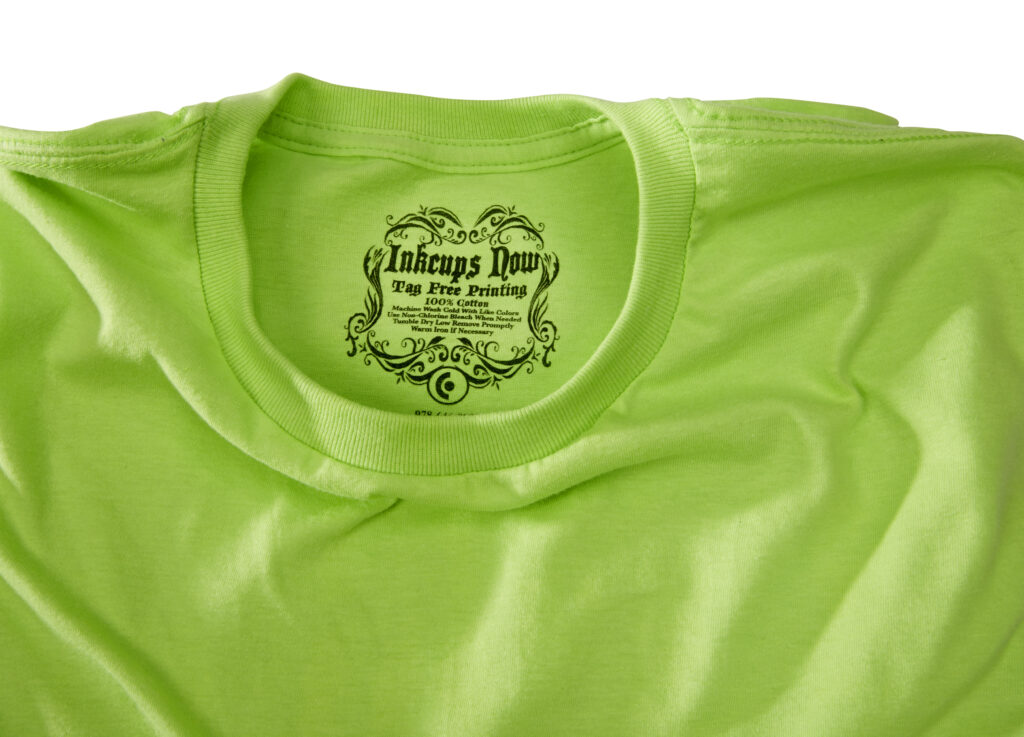- Equipment
- Inks & Supplies
- Services
- Applications
- Tagless
- Resources
- About Us
- Contact Us

Has the time has come to make a decision regarding how to tackle shirt labels on your apparel? The age-old question is tagless or tearaway tag? Three main methods of shirt label printing methods of the tagless variety are: heat transfers, pad printing, or screen printing.
For those not familiar with the term ‘tagless’, let’s begin there. Tagless label printing is the process of directly printing the logo onto the fabric, bypassing the use of a traditional fabric tag sewn into a garment. By today’s standards fabric tags are a nuisance to all ages. We have grown accustomed to everything from underwear, to athleisure, to uniforms to be comfortable and tagless. Accordingly, printing directly onto the piece of clothing can save time, money, and consumables.
As touched upon earlier there are three methods primarily utilized when it comes to tagless printing. Let’s explore the three methods:
Pad printing is often the preferred method of tagless printing as there are low start-up costs, low operating costs, instant dry time, high durability, and comfort. Both heat transfers and screen printing can result in labels cracking or peeling off.
Inkcups offers multiple different pad printers to streamline your business when it comes to different shirt label printing method. When it comes down to deciding which pad printer is the best fit for your operation consider the following factors:
The B100 is the perfect pad printer for those looking to print one-color tagless tags that have an artwork size of up to 3” hosted in a compact table-top sized unit. Operating at full speed, the B100’s output is between 900 to 1300 impressions per hour.
The Brite Care Label Printing Machine was created for those wishing to print tags on dark color fabrics. Pair this pad printer with our SB Brite Opaque Garment Printer Ink to have high contrast between the ink and fabric, even on the darkest color fabrics like navy and black.
The B150 Large Image Care Label Printing Machine is a pad-printer for one-color by graphics that are up to 5.5” in diameter.
Inkcups’s ICN2200-PS accommodates two-color graphics and images that are up to 3” in diameter.
As you can see here, the main differentiators between the pad printers that Inkcups offers is if the pad printer can print one or two colors, and the image size.
Inkcups offers three different tagless printing inks at the time being. Let’s explore the three lines in greater detail.
Ink is specially formulated for fabric apparel to achieve superior adhesion, just like that of drinkware. Within the textile industry we are focused ink adhesion lasting a set amount of industrial washing machine runs.
The ink most used for apparel tags on the market is the SB Ink for Apparel Tags. It is high quality, high flexibility, quick drying, and will not crack on even the trickiest fabrics. Fast drying is a must-have quality when it comes to pad printing as operators quickly stack apparel pieces after meeting the pad and can’t be bothered with smudging or bleeding.
The most sustainable garment ink available today is the SB Eco Series for Apparel Tags. This line of ink holds all the qualities of the original SB Ink while being eco-sustainable, lacking harsh chemicals. This line has 24 different colors and adheres to 98% of fabrics including cotton, polyester, rayon, and many more.
The third line of ink is the SB Brite Opaque Garment Printer Ink. It consists of three colors: Brite white, Brite pink, and Brite yellow and is intended to really pop when it comes to light-on-dark prints. This line of ink was created especially for the Brite Care Label Printing Machine. As the name implies it is super opaque for crisp prints.
It should be noted that all three of the pad printing inks that Inkcups carries produce soft-hand prints which means that if you were to run your hand over the printed label, it would be almost unnoticeable.
Now that you have come to the conclusion that your business would be best served by pad printing for tagless applications get in contact with a sales representative in your area to discuss your specific wants and needs. Contact us today!
Back to Blog Home
Add Your Comment